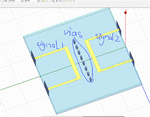maxsidou
Member level 1
hello everyone, GND vias are usually arranged in a row to isolate signals from both sides as shown in the figure below. I'm curious how to access the isolation effects. there are many papers that draw the EM fields with and without the isolation vias but still not analyzed in quantity. Is there any better ways? thanks for your response.
